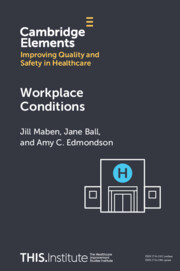Crossref Citations
This Element has been
cited by the following publications. This list is generated based on data provided by Crossref.
Fulop, Naomi J.
and
Ramsay, Angus I. G.
2023.
Governance and Leadership.
Kirk, Kate
Cohen, Laurie
Timmons, Stephen
Edgley, Alison
and
Santos, José Luís
2023.
“Zero to Hero”: Conceptualising Time as a Moderator of Nurses’ Emotional Labour on the Front Line.
Journal of Nursing Management,
Vol. 2023,
Issue. ,
p.
1.
Dakin, Francesca
Rai, Tanvi
Paparini, Sara
and
Greenhalgh, Trisha
2023.
Supporting your support staff during crises: recommendations for practice leaders to develop a relational workplace.
BMJ Leader,
Vol. 7,
Issue. Suppl 2,
p.
1.1.
Cupit, Caroline
Tarrant, Carolyn
and
Armstrong, Natalie
2023.
Reducing Overuse.
Street, Andrew
and
Gutacker, Nils
2023.
Health Economics.
Maben, Jill
Ball, Jane
and
Edmondson, Amy C.
2023.
Workplace Conditions.
Brazil, Victoria
Purdy, Eve
and
Bajaj, Komal
2023.
Simulation as an Improvement Technique.
Zenkina, V. І.
2023.
Priority problems in occupational hygiene and safety of medical workers in emergency situations (from the experience of overcoming the Covid-19 pandemic).
Environment & Health,
p.
29.
Cribb, Alan
Entwistle, Vikki
and
Mitchell, Polly
2024.
Values and Ethics.
Papoutsi, Chrysanthi
Greenhalgh, Trisha
and
Marjanovic, Sonja
2024.
Approaches to Spread, Scale-Up, and Sustainability.
Taylor, Cath
Maben, Jill
Jagosh, Justin
Carrieri, Daniele
Briscoe, Simon
Klepacz, Naomi
and
Mattick, Karen
2024.
Care Under Pressure 2: a realist synthesis of causes and interventions to mitigate psychological ill health in nurses, midwives and paramedics.
BMJ Quality & Safety,
p.
bmjqs-2023-016468.
Nurhidayat, Nurhidayat
Pribadi, Ulung
Nurmandi, Achmad
Congge, Umar
Ahdarrijal, Yujitia
Jusman, Y.
Mutiarin, D.
Paksie, A.
Saptutyningsih, E.
Pau Loke, S.
Khaliq, A.
Ridzuan, A.R.
and
Tenorio, C.B.
2024.
Applying the Umega Model and Theory of Planned Behavior to Analyze Public Service Mall User Intentions in Sinjai, Indonesia.
SHS Web of Conferences,
Vol. 204,
Issue. ,
p.
03011.
Jun, Gyuchan Thomas
Hignett, Sue
and
Clarkson, P. John
2024.
Design Creativity.
Mohammed, Mohammed Amin
2024.
Statistical Process Control.
Mitchell, Andrew EP
2024.
Commentary: Relationship between resilience, social support and psychological well-being in nursing students.
Journal of Research in Nursing,
Vol. 29,
Issue. 8,
p.
732.
Williams, Sharon J.
2025.
Supply Chain Management.
Fahrendorff, Tim
2025.
New Work und Arbeitsschutz.
p.
47.
Dakin, Francesca H
Hemmings, Nina
Kalin, Asli
Moore, Lucy
Ladds, Emma
Payne, Rebecca
Rosen, Rebecca
Byng, Richard
Wherton, Joseph
Wieringa, Sietse
and
Greenhalgh, Trisha
2025.
Technostress, technosuffering, and relational strain: a multi-method qualitative study of how remote and digital work affects staff in UK general practice.
British Journal of General Practice,
Vol. 75,
Issue. 752,
p.
e211.
Toulany, Alene
and
Shojania, Kaveh G.
2025.
Measurement for Improvement.
Creese, Jennifer
Byrne, John Paul
Conway, Edel
O’Connor, Gerard
and
Humphries, Niamh
2025.
“They say they listen. But do they really listen?”: A qualitative study of hospital doctors’ experiences of organisational deafness, disconnect and denial.
Health Services Management Research,
Vol. 38,
Issue. 2,
p.
62.



